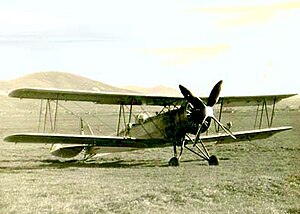| This article includes a list of references, related reading, or external links, but its sources remain unclear because it lacks inline citations. Please help improve this article by introducing more precise citations. (June 2013) (Learn how and when to remove this message) |
| Ca 161 | |
|---|---|

| |
| Role | High-altitude experimental aircraftType of aircraft |
| Manufacturer | Caproni |
| Designer | Rodolfo Verduzio |
| First flight | 1936 |
The Caproni Ca.161 was an aircraft built in Italy in 1936, in an attempt to set a new world altitude record. It was a conventional biplane with two-bay, staggered wings of equal span, based on Caproni's Ca.113 design. The pressure-suited pilot was accommodated in an open cockpit.
Operational history
On 8 May 1937, Lieutenant Colonel Mario Pezzi broke the world altitude record with a flight to 15,655 m (51,362 ft). The following year, Pezzi broke the record again in the more powerful Ca.161bis, making a flight to 17,083 m (56,047 ft) on 22 October 1938. The Grob Strato 2C broke this record for piston-powered crewed airplanes generally in 1995, but as of 2024 it still stands for piston-powered biplanes, and for crewed single-engine piston aircraft.
A final altitude record for floatplanes was set on 25 September 1939 in the float-equipped Ca.161Idro, piloted by Nicola di Mauro to 13,542 m (44,429 ft). As of 2024, this record also still stands.
Variants
- Ca.161 – original version with Piaggio P.XI R.C.72 engine
- Ca.161bis – improved version with Piaggio P.XI R.C.100/2v
- Ca.161Idro – floatplane version
Specifications (Ca.161bis)

Data from Italian Civil and Military Aircraft 1930–1945 apart from weights
General characteristics
- Crew: one, pilot
- Length: 8.25 m (27 ft 1 in)
- Wingspan: 14.25 m (46 ft 9 in)
- Height: 3.50 m (11 ft 6 in)
- Wing area: 35.5 m (382 sq ft)
- Empty weight: 1,205 kg (2,657 lb)
- Gross weight: 1,650 kg (3,638 lb)
- Powerplant: 1 × Piaggio P.XI R.C.100/2v 14-cylinder radial driving a 4-blade propeller , 560 kW (750 hp)
Performance
- Maximum speed: 100 km/h (60 mph, 52 kn)
- Service ceiling: 17,083 m (56,047 ft)
- Rate of climb: 10.3 m/s (2,020 ft/min)
See also
Aircraft of comparable role, configuration, and era
References
- "Flight in the Depression Timeline". HowStuffWorks. 2008-07-25. Retrieved 2023-04-20.
- Taylor, Michael J. H. (1989). Jane's Encyclopedia of Aviation. London: Studio Editions. p. 236.
- Thompson, Jonathan (1963). Italian Civil and Military Aircraft 1930–1945. Fallbrook, California: Aero Publishers, Inc. p. 93.